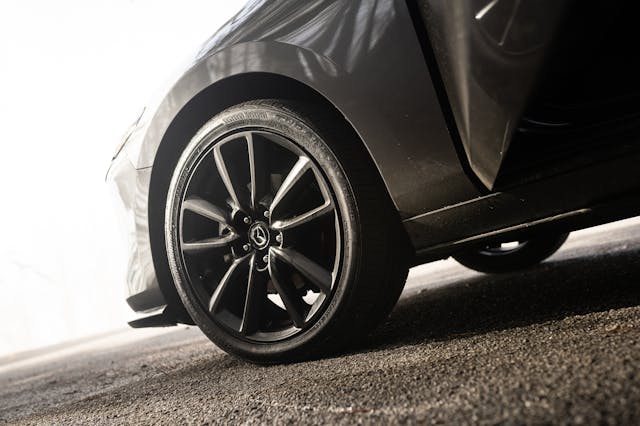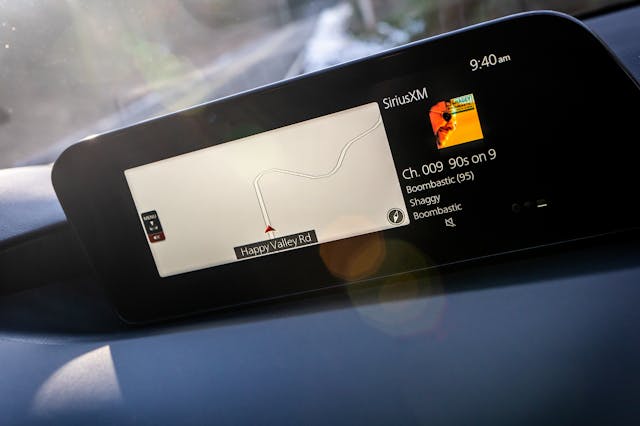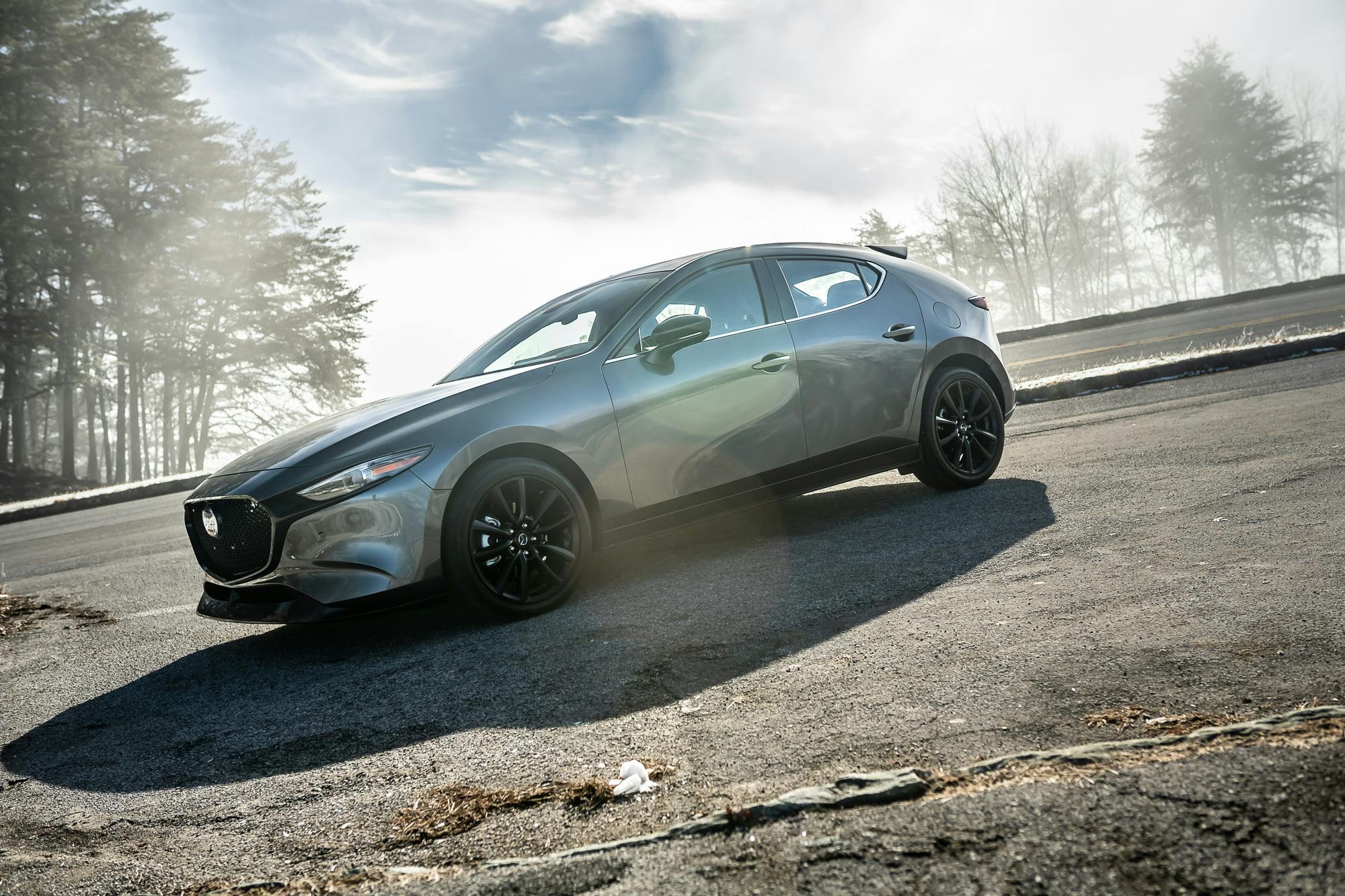Media | Articles
Review: 2021 Mazda 3 2.5T AWD
Perhaps you have spent the past few years paying zero attention to the world of new cars. This is forgivable! Most new cars are heavy and complex and not that interesting. An overwhelming majority are also now something like a truck, which is fine, if you need or want a truck.
Come back! Don’t leave! It gets better.
The upside: Most new cars are good at their intended work. A few are even satisfying in the classic sense, bleeding quiet happy into your life without fuss.
A select few of those cars are good enough to make your knees weak, a reason to drive around for hours even when you have nowhere to go.
That last group is almost entirely not cheap.
Marketplace
Buy and sell classics with confidence
Let’s focus on one of the quiet guys instead.

If you go by the numbers, America does not give a toot about Mazdas. Or hatchbacks. Or small cars, really, at least not any more. We used to buy a lot of small cars and hatches, but that was when gas cost solid money. Now most of us buy trucklike things. The why of that shift is not for this space, but the sales figures are interesting. Take the Mazda 3—compact hatch, light on its feet, long one of the best in the business, received a ground-up refresh for 2019. Just 50,000 examples were sold in the United States that year. For context, in that same period, Mazda’s American arm sold more than 154,000 CX-5s.
The CX-5 is a compact and carlike SUV, what the industry calls a crossover. It shares a platform with the previous 3, though the 3 is shorter and lighter. An idiot would have a hard time telling the two cars apart in a dark room, but one is slightly more trucklike and sells better. Witness, to paraphrase Monty Python, the violence in the system. Or simply in the competition. In 2019, American Honda moved more than 300,000 Civics. Toyota sold this country more than 300,000 Corollas. Subaru’s U.S. contingent found homes for more than 66,000 Imprezas that year. The current version of that model still outsells the 3, and it is ancient in new-car terms, now a whopping five years old. (Predictable trivia department: The Civic, Corolla, and Impreza are each outsold by their respective crossover siblings. But you probably guessed that.)
Long story short? Faced with the prospect of buying a spanking fresh Mazda car, Americans would rather buy a Honda, a Toyota, a gray-haired Subaru, or a trucklet. Even if that Mazda car is, in most trims, more giggles than most of that stuff and about as practical.
Americans have curious priorities on this front, says me.

The Mazda in question is sold as both hatchback and sedan, in forms ranging from 155-hp front-drive stripper to turbocharged, 250-hp, all-wheel-drive adult device. The latter spec is arguably the most special on offer, but you have to be paying attention to notice. That machine holds four people comfortably and feels all of a piece. Its interior is understated without feeling cheap, the details simple and tasteful.
Twenty-five years ago, that 250-horse list of demands would have worked out to something like a brand-new Audi S4. Now it produces a $32,000, 3400-pound Japanese device with another four inches of wheelbase and styling the curvy adult business. (Translation: Haunches like a lady’s hips, bumper plastic styled deeply unlike robot testicle.)
Mazda has built four generations of 3. The bones launched in 2019 were small-car S.O.P. You got a transverse engine, a strut front suspension, and a relatively low-cost torsion beam between the rear wheels. As of 2021, the 3 is available with one of three four-cylinders. The sedan version offers the most choice, with a 2.0-liter (155 hp), a 2.5 (186 hp), or a 2.5 turbo (250 hp). For gearbox, you get either a six-speed, torque-converter automatic or a six-speed manual. The build matrix is only frustrating if you like front-drive turbo hot hatches and/or small fours: Picking the hatch automatically yanks the 2.0 from your order sheet, and you can’t pair the 250-horse 2.5 with either front-drive or a manual.

That clutch-pedal shut-out can seem like a big deal if you’re bent a certain way. The 2.5T is a slick and responsive little zinger, low on lag and happy at high rpm. It begs for a manual, but the real news lies in the car we tested. The all-wheel-drive hardware here is an electronically controlled and clutch-based package that Mazda calls i-Activ. A $1400 option, the system is essentially a retuned version of the hardware found in the CX-5.
Front-drive has long been Mazda’s chassis-genius stock in trade, but all-wheel-drive helps sell cars, especially in America’s Northeast. The i-Activ bits met the 3 for the 2020 model year but were only last year given the power they deserved, with the release of the 2.5T. Spec a nonturbo 3 with four driven wheels, you get a machine that feels like Diet Coke: slightly bland, an obvious substitute for something better. Lethargy seems woven into the carpet. Tick the box for the turbo, however, and the car wakes up. Not for the reasons you think.

The software is the star here, different from Mazda SUV practice or the code in the nonturbo, all-wheel-drive 3. The center diff in those cars is dialed to make the car behave mostly as a front-driver, the rear driveshaft there primarily for slick-surface catch-up. By contrast, the turbo’s thinky bits use sensor data (the usual suspects like steering angle, yaw, and lateral acceleration) and brake-based torque vectoring to help the car dance more off its back axle. The rear half shafts gain or lose drive in corners at clever times, and the whole setup runs nudgy little physics games—a quiet dab of brake here, a weight shift there—to help the chassis feel more alive. If you believe the marketing, this even happens at the expense of all-out grip.
This practice isn’t new, but it is a gift on a car of this price. More important, the tuning borders on genius. Mazda says the point here was natural feel. Natural is a subjective term, but either way, a once sleepy little all-wheel-drive car now turns from the hips and shouts intention at your spine. You don’t think about the driveline so much as simply marvel at how the relatively soft 3 desperately wants to point, and how you feel pretty good about that fact pretty much all the time.

Performance is, to borrow the old Rolls-Royce line, sufficient. Two hundred and fifty horsepower is no longer the stuff of hot-hatch legend, but it’s enough here. Car and Driver ran an all-wheel-drive 2.5T to 60 in 5.6 seconds, two tenths faster than the old Mazdaspeed 3, dead since 2013. That car was a 263-hp spaz-wagon built mostly of boost and torque steer, but the speed here is far more sedate. The six-speed automatic on tap shifts sleepily but generally has the right idea; its manual mode is crisp and responsive enough that back roads end up prompting you to shift on your own. The steering won’t win any prizes, but if the wheel is a little numb and heavy on center, it’s also talkative and accurate enough to be fun.
This is a turbocharged, all-wheel-drive hatchback that doesn’t feel like a performance car. The Mazda is calmer than that, more sedate, even, than the longtime class grown-up, the VW GTI. (For the record, the GTI makes less power and feels less lively, but it is available with a manual, and its cabin is noticeably more airy.) The sum here is basically that old-school sport-sedan vibe perfected by the Germans, where chassis is faster than engine and the driver happily alternates between chilling down the road and wringing the car’s neck.
Subtlety, in other words. Rare these days, and appealing. A Civic feels more disposable and try-hard, and a Corolla looks cheaper while feeling less vibrant. The Impreza seems more purposely agricultural. Hyundais of similar ability are too often boy-racer. The Mazda is a nice balance.

Every 2.5T 3 gets a host of standard features: a lively and crisp 12-speaker Bose stereo; a tidy, 8.8-inch center display tucked unobtrusively into the dash; keyless entry; stop-and-go radar cruise; blind-spot monitoring; adaptive lighting; lane-departure warning; 18-inch alloys; auto headlights; rain-sensing wipers; a 2-GB trial for the in-car wifi hotspot. The Premium Package ($2850) brings in leather and a short list of tech-oriented safety functions.
Even bog stock, however, an all-wheel-drive turbo Mazda 3 is not cheap. It can seem even less so if you discount the intangibles. Don’t.

It’s hard to drive something like this without wondering how people will discover it. Subtlety sings softly in a world of shouting. There’s no celebrity CEO at this brand, no high-zoot performance model to lure people into showrooms, no bargain-bin pricing or vocal ownership cult. Nor is there much of what once made Mazda, Mazda. The marque has been cutting its motorsport spend for years, and the Mazdaspeed sub-brand is dead. Dead too is the old “Zoom Zoom” tagline, a happily childish phrase that suggested you love driving in the same way that a kid loves anything, absent pretense or worry on appearance.
Such a good lesson. There are others here. The notion, for example, that fun cars don’t necessarily require a traditional approach, or a billion horses, or a front bumper like a pissed-off sewer grate. And while compact crossovers sell like crazy, rare is the porky trucklet that can keep a person up at night, thinking about the road they’ll see tomorrow.

To paraphrase a Hugh Grant film from the 1990s, what we are left with, then, is simply a very good and unique little car, standing in front of a very good and big country, asking why no one is paying attention.
Your guess is as good as ours.
[For a more tech-focused take on the Mazda 3 2.5T AWD, check out Bozi Tatarevic’s breakdown here.]
2021 Mazda 3 2.5 Turbo AWD
Base price/as-tested: $32,045 / $35,315
Highs: Pretty curves, classy cabin. Chassis charming beyond the blueprint.
Lows: That slinky roofline and thick C-pillar put a light hurt on rear-seat room and driver visibility. Driveline begs for a manual gearbox.
Summary: A unique and delightfully restrained answer to an old question.











